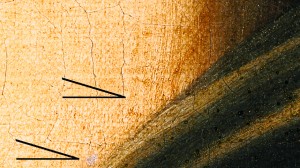It is well known that Leonardo was ambidextrous. He wrote and painted with the left hand principally by choice. One thing is certain at the beginning of the 16th Century in Renaissance Italy: Leonardo da Vinci, besides his other unique characteristics, was one of the only artists of great repute identified to paint with the left hand. Searching for and finding evidence of left-handed brushstrokes in his paintings does not however automatically determine his authorship, but evidence of left-handed brushstrokes in a Masterpiece of the early 16th Century may suggest a strong link to Leonardo.
Subjecting the ‘Earlier Mona Lisa’ to intense magnification, it can be noted how the paint strokes are applied in both the figure and the background. Careful observation shows that the brushstrokes for the background are heavy where traces of the bristles’ direction can be followed on how the paint film was applied. By contrast, traces of the brushstrokes on the figure, particularly the face and hands, are extremely difficult to determine, indicating the application of very thin delicate layers built-up with the use of fine silk brushes. This created in these areas the exceptional ‘sfumato’ effect that Leonardo mastered.

Using intense magnification on the ‘Earlier Mona Lisa’, some downward-extending brushstrokes are detectable on the right side of the neckline, revealing the characteristics of a left-handed application.
In dealing with drawings, it is much easier to determine whether the artist is right- or left-handed: clues lie in the direction of the cross-hatching, the shades that evolve from that, and the location of greatest stress with the pencil’s use. For left-handed artists, the main characteristic is that the sloping lines are angled from lower right to upper left, or downwards from upper left to lower right. The converse applies for a right-handed artist. To apply his broad thin washes, Leonardo likely used a flat chisel-type brush on the downward strokes. The natural inclination of the modeling of the right side of the neck suggests the angles where the bristles leave the canvas. These downward strokes indicate a left-handed artist. Similar strokes can be identified on the subject’s face and right hand.
There are stylistic differences between the manner in which the flesh-tones; figure (face and head), neck, hands and lower parts of the columns, are painted that contrast with the execution of the landscape background. As described earlier, it is likely that the background area over the mountains, and sky, were left as they are by a later appropriation. The original work, the conception and portrait were painted by a left-handed master.